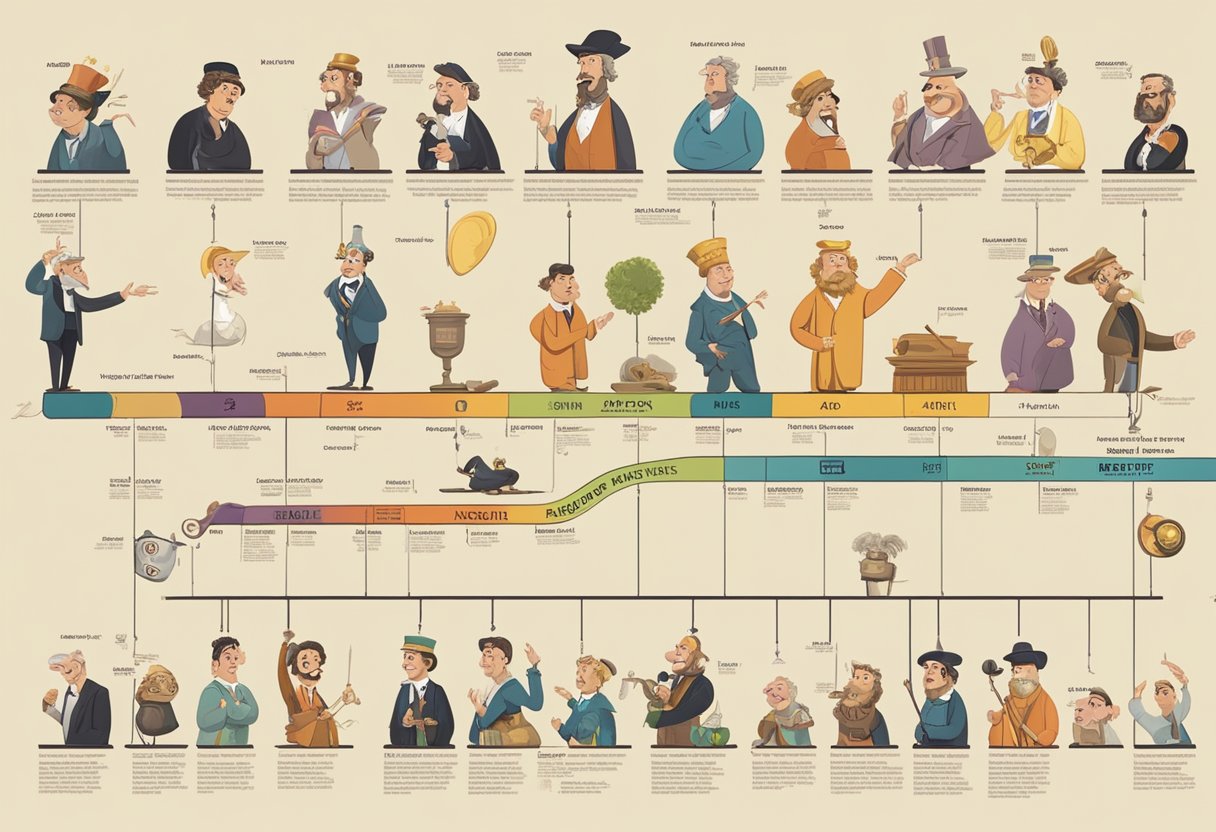Types Of Comedy
Comedy is a form of entertainment that has been around for centuries. It is a type of performance that aims to make audiences laugh and feel good. There are many different types of comedy, each with its unique style, delivery, and context. Understanding the different types of comedy can help you appreciate the art form and enjoy it more fully.
The history and evolution of comedy are fascinating subjects that can shed light on the cultural impact and societal functions of humor. Major comedy genres include satire, parody, irony, farce, and many others. These classifications overlap, and most comedians can fit into multiple genres. In modern media, comedy has become a ubiquitous presence, with sitcoms, stand-up comedy, and comedy films being popular forms of entertainment. Influential figures in comedy, such as Charlie Chaplin, Lucille Ball, and Richard Pryor, have left a lasting legacy on the art form.
Key Takeaways
- Comedy is a form of entertainment that aims to make audiences laugh and feel good.
- There are many different types of comedy, each with its unique style, delivery, and context.
- Understanding the history and evolution of comedy, major comedy genres, and influential figures in comedy can help you appreciate the art form and enjoy it more fully.
History and Evolution of Comedy

Comedy has been an integral part of human culture since ancient times. The development of comedy can be traced back to the ancient Greek civilization, where it was considered an important aspect of social and political life.
Ancient Beginnings
The earliest form of comedy was known as “Old Comedy” and was popularized by the Greek playwright Aristophanes. Old Comedy was characterized by its use of satire, parody, and political commentary. It was performed in front of large audiences in open-air theaters and was often used as a means of social commentary and criticism of the ruling class.
The Roman Empire also had its own form of comedy, known as “New Comedy”. This form of comedy was less political and more focused on everyday life and relationships. It was popularized by playwrights such as Plautus and Terence.
Development Through the Ages
Comedy continued to evolve throughout the ages, with notable contributions from William Shakespeare and Moliere. Shakespeare’s plays, such as “A Midsummer Night’s Dream” and “Twelfth Night”, were known for their witty dialogue and use of mistaken identity. Moliere’s plays, such as “Tartuffe” and “The Misanthrope”, were known for their social commentary and satire.
In the modern era, comedy has taken on many different forms, including stand-up comedy, sitcoms, and sketch comedy. Comedians such as Richard Pryor, George Carlin, and Dave Chappelle have used comedy as a means of addressing social and political issues.
Overall, comedy has played an important role in human culture throughout history. Its evolution and development have been shaped by human nature and the social and political climate of the times.
Major Comedy Genres
Comedy is a vast genre of entertainment that has many different styles and formats. Major comedy genres include slapstick and physical comedy, satire and parody, and dark and black comedy. Each of these genres has its own unique approach to humor, and offers a different perspective on society and human nature.
Slapstick and Physical Comedy
Slapstick and physical comedy is a type of comedy that relies on exaggerated physical actions and movements to create humor. It often involves characters getting hit, falling, or engaging in other physical mishaps. Slapstick comedy has been popular throughout history, and has been used in everything from silent films to modern-day comedies.
Satire and Parody
Satire and parody are two closely related genres of comedy that use humor to comment on society and culture. Satire is a type of comedy that uses irony, sarcasm, and other forms of humor to criticize and expose the flaws and shortcomings of society. Parody, on the other hand, is a type of comedy that imitates and exaggerates the style and content of another work in order to create humor.
Dark and Black Comedy
Dark and black comedy is a type of comedy that deals with serious and often taboo subjects, such as death, disease, and tragedy. It often uses humor to explore the darker side of human nature, and can be both thought-provoking and controversial. Black comedy has been used in everything from literature to film, and has been both praised and criticized for its use of humor in the face of tragedy.
In addition to these major comedy genres, there are many other types of comedy, such as burlesque, farce, screwball comedy, and more. Each of these genres offers its own unique approach to humor, and has its own set of conventions and techniques. Whether you prefer slapstick, satire, or dark comedy, there is sure to be a type of comedy that will make you laugh.
Comedy in Modern Media
With the advent of modern media, comedy has taken on many new forms. From traditional stand-up comedy to online and alternative platforms, there are now more ways than ever to enjoy a good laugh.
Film and Television
Film and television have long been a popular medium for comedy. From classic comedies like “Some Like It Hot” and “The Marx Brothers” to modern hits like “The Office” and “Brooklyn Nine-Nine,” there is no shortage of comedic entertainment on the small and big screens. Situational comedies, or sitcoms, have been especially popular since the 1950s, and continue to be a staple of television programming.
Stand-Up and Live Performances
Stand-up comedy and live performances have been a mainstay of comedy for decades. Many comedians got their start performing in small clubs and venues, honing their craft and developing their unique style. Today, stand-up comedy is still a popular form of entertainment, with many comedians performing in theaters and arenas around the world.
Online and Alternative Platforms
In recent years, the rise of online and alternative platforms has given rise to new genres of comedy. Sketch comedy shows like “Saturday Night Live” and “Key & Peele” have gained massive followings on YouTube and other streaming platforms. Social media has also given rise to a new generation of comedians, with many using platforms like Instagram and TikTok to share their comedy with the world.
Overall, comedy in modern media has never been more diverse or accessible. Whether you prefer traditional sitcoms or the latest viral video, there is something for everyone to enjoy.
Influential Figures in Comedy
Comedy has always been an integral part of the entertainment industry, and there have been many comedians throughout history who have made a significant impact on the genre. In this section, we will discuss some of the most influential figures in comedy, both classic icons, and contemporary comedians.
Classic Icons
Charlie Chaplin is considered one of the greatest comedians of all time. His iconic character, the Tramp, is recognized worldwide and has become an enduring symbol of comedy. His films, including “The Kid,” “City Lights,” and “Modern Times,” are still watched and enjoyed today.
The Three Stooges, comprising Moe Howard, Larry Fine, and Curly Howard, are another classic comedy trio that has left a lasting impression on the genre. Their slapstick humor and physical comedy have influenced many comedians that followed them.
The Marx Brothers, consisting of Groucho, Chico, Harpo, Gummo, and Zeppo, were a family of comedians who dominated the comedy scene in the 1930s and 1940s. Their films, including “Duck Soup” and “A Night at the Opera,” are considered classics of the genre.
Contemporary Comedians
Monty Python, a British comedy group, emerged in the 1960s and became a cultural phenomenon. Their surreal and absurdist humor, showcased in their television show “Monty Python’s Flying Circus” and films like “Monty Python and the Holy Grail,” has influenced many comedians that followed them.
Mel Brooks is another contemporary comedian who has made a significant impact on the genre. His films, including “Blazing Saddles” and “Young Frankenstein,” are considered classics of the genre. Brooks’ irreverent humor and satirical take on popular culture have influenced many comedians that followed him.
Woody Allen is a comedian, writer, and filmmaker who has made a significant impact on the genre. His films, including “Annie Hall” and “Manhattan,” are considered classics of the genre. Allen’s neurotic and self-deprecating humor has influenced many comedians that followed him.
The Coen Brothers, consisting of Joel and Ethan Coen, are filmmakers who have made a significant impact on the comedy genre. Their films, including “The Big Lebowski” and “Fargo,” are known for their quirky characters, dark humor, and unique storytelling style. The Coen Brothers’ films have influenced many comedians and filmmakers that followed them.
In conclusion, these are just a few of the many influential figures in comedy. Their contributions to the genre have helped shape it into what it is today, and their influence can be seen in the work of many contemporary comedians.
Cultural Impact and Societal Functions
Comedy is a form of entertainment that has been around for centuries and has evolved over time. It has played an important role in shaping cultures and societies. The impact of comedy on society is multifaceted, and it can serve as social commentary or provide therapeutic benefits.
Comedy as Social Commentary
Comedy has often been used as a tool for social commentary. It can be used to highlight societal issues and bring attention to them. Through humor, comedians can address topics that may be difficult to discuss in a serious manner. This can be seen in the use of satire, which is a form of comedy that uses irony, exaggeration, and ridicule to expose and criticize societal vices.
Comedy can also be used to challenge societal norms and expectations. It can be used to question authority and challenge the status quo. This can be seen in the use of parody, which is a form of comedy that imitates a work of art, literature, or music in order to ridicule or criticize it.
The Therapeutic Role of Laughter
Comedy can also serve a therapeutic role in society. Laughter has been shown to have numerous benefits for mental and physical health. It can reduce stress, boost the immune system, and improve mood.
Comedy can also be used as a corrective tool. It can be used to address and correct negative behaviors and attitudes. Through humor, comedians can provide a lighthearted way to address societal issues and encourage positive change.
In conclusion, comedy has played an important role in shaping cultures and societies. It can serve as social commentary or provide therapeutic benefits. Whether it is used to challenge societal norms or address negative behaviors, comedy has the power to bring people together and encourage positive change.






